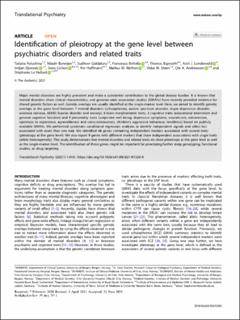Identification of pleiotropy at the gene level between psychiatric disorders and related traits
| dc.contributor.author | Polushina, Tatiana | |
| dc.contributor.author | Banerjee, Niladri | |
| dc.contributor.author | Giddaluru, Sudheer | |
| dc.contributor.author | Bettella, Francesco | |
| dc.contributor.author | Espeseth, Thomas | |
| dc.contributor.author | Lundervold, Astri J. | |
| dc.contributor.author | Djurovic, Srdjan | |
| dc.contributor.author | Cichon, Sven | |
| dc.contributor.author | Hoffmann, Per | |
| dc.contributor.author | Nöthen, Markus M. | |
| dc.contributor.author | Steen, Vidar Martin | |
| dc.contributor.author | Andreassen, Ole A. | |
| dc.contributor.author | Le Hellard, Stéphanie | |
| dc.date.accessioned | 2022-01-25T10:08:20Z | |
| dc.date.available | 2022-01-25T10:08:20Z | |
| dc.date.created | 2021-09-08T11:03:42Z | |
| dc.date.issued | 2021 | |
| dc.identifier.issn | 2158-3188 | |
| dc.identifier.uri | https://hdl.handle.net/11250/2839153 | |
| dc.description.abstract | Major mental disorders are highly prevalent and make a substantial contribution to the global disease burden. It is known that mental disorders share clinical characteristics, and genome-wide association studies (GWASs) have recently provided evidence for shared genetic factors as well. Genetic overlaps are usually identified at the single-marker level. Here, we aimed to identify genetic overlaps at the gene level between 7 mental disorders (schizophrenia, autism spectrum disorder, major depressive disorder, anorexia nervosa, ADHD, bipolar disorder and anxiety), 8 brain morphometric traits, 2 cognitive traits (educational attainment and general cognitive function) and 9 personality traits (subjective well-being, depressive symptoms, neuroticism, extraversion, openness to experience, agreeableness and conscientiousness, children’s aggressive behaviour, loneliness) based on publicly available GWASs. We performed systematic conditional regression analyses to identify independent signals and select loci associated with more than one trait. We identified 48 genes containing independent markers associated with several traits (pleiotropy at the gene level). We also report 9 genes with different markers that show independent associations with single traits (allelic heterogeneity). This study demonstrates that mental disorders and related traits do show pleiotropy at the gene level as well as the single-marker level. The identification of these genes might be important for prioritizing further deep genotyping, functional studies, or drug targeting. | en_US |
| dc.language.iso | eng | en_US |
| dc.publisher | Springer Nature | en_US |
| dc.rights | Navngivelse 4.0 Internasjonal | * |
| dc.rights.uri | http://creativecommons.org/licenses/by/4.0/deed.no | * |
| dc.title | Identification of pleiotropy at the gene level between psychiatric disorders and related traits | en_US |
| dc.type | Journal article | en_US |
| dc.type | Peer reviewed | en_US |
| dc.description.version | publishedVersion | en_US |
| dc.rights.holder | Copyright The Author(s) 2021 | en_US |
| dc.source.articlenumber | 410 | en_US |
| cristin.ispublished | true | |
| cristin.fulltext | original | |
| cristin.qualitycode | 1 | |
| dc.identifier.doi | 10.1038/s41398-021-01530-4 | |
| dc.identifier.cristin | 1932351 | |
| dc.source.journal | Translational Psychiatry | en_US |
| dc.identifier.citation | Translational Psychiatry. 2021, 11, 410. | en_US |
| dc.source.volume | 11 | en_US |
Tilhørende fil(er)
Denne innførselen finnes i følgende samling(er)
-
Department of Clinical Science [2310]
-
Registrations from Cristin [9688]

